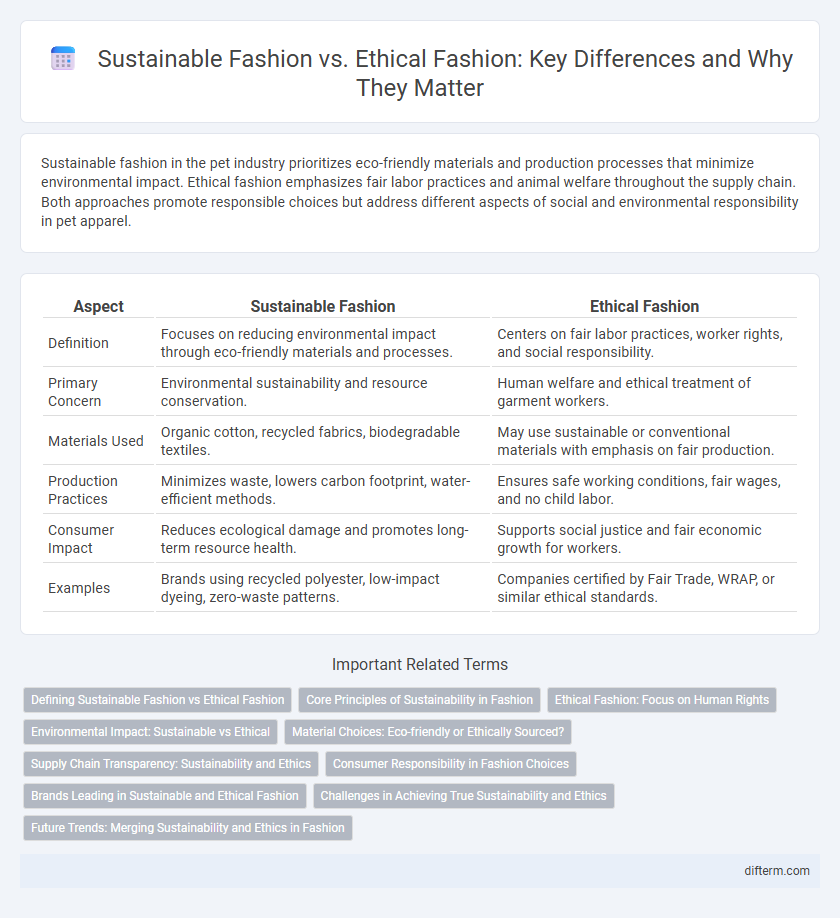Sustainable fashion in the pet industry prioritizes eco-friendly materials and production processes that minimize environmental impact. Ethical fashion emphasizes fair labor practices and animal welfare throughout the supply chain. Both approaches promote responsible choices but address different aspects of social and environmental responsibility in pet apparel.
Table of Comparison
| Aspect | Sustainable Fashion | Ethical Fashion |
|---|---|---|
| Definition | Focuses on reducing environmental impact through eco-friendly materials and processes. | Centers on fair labor practices, worker rights, and social responsibility. |
| Primary Concern | Environmental sustainability and resource conservation. | Human welfare and ethical treatment of garment workers. |
| Materials Used | Organic cotton, recycled fabrics, biodegradable textiles. | May use sustainable or conventional materials with emphasis on fair production. |
| Production Practices | Minimizes waste, lowers carbon footprint, water-efficient methods. | Ensures safe working conditions, fair wages, and no child labor. |
| Consumer Impact | Reduces ecological damage and promotes long-term resource health. | Supports social justice and fair economic growth for workers. |
| Examples | Brands using recycled polyester, low-impact dyeing, zero-waste patterns. | Companies certified by Fair Trade, WRAP, or similar ethical standards. |
Defining Sustainable Fashion vs Ethical Fashion
Sustainable fashion emphasizes minimizing environmental impact by using eco-friendly materials, reducing waste, and promoting resource conservation throughout the garment lifecycle. Ethical fashion focuses on improving labor conditions, ensuring fair wages, and promoting human rights within the supply chain. Both concepts aim to transform the fashion industry but address different aspects: sustainability targets ecological responsibility, while ethics prioritize social justice.
Core Principles of Sustainability in Fashion
Sustainable fashion centers on minimizing environmental impact through eco-friendly materials, energy-efficient production, and waste reduction. Ethical fashion emphasizes fair labor practices, ensuring safe working conditions and equitable wages throughout the supply chain. Both principles drive the industry toward transparency, accountability, and long-term social and environmental responsibility.
Ethical Fashion: Focus on Human Rights
Ethical fashion prioritizes human rights by ensuring fair wages, safe working conditions, and the empowerment of garment workers throughout the supply chain. Brands committed to ethical fashion often implement transparent labor practices, avoiding exploitation and child labor. This approach promotes social justice and dignity for workers while fostering sustainable development within the fashion industry.
Environmental Impact: Sustainable vs Ethical
Sustainable fashion prioritizes reducing environmental impact through eco-friendly materials, waste minimization, and energy-efficient production processes, aiming to lower carbon footprints and resource depletion. Ethical fashion emphasizes fair labor practices and humane working conditions, indirectly benefiting the environment by promoting responsible sourcing and manufacturing standards. Both approaches intersect on environmental stewardship but differ in primary focus, with sustainability targeting ecological preservation and ethical fashion addressing social responsibility within the supply chain.
Material Choices: Eco-friendly or Ethically Sourced?
Sustainable fashion emphasizes the use of eco-friendly materials such as organic cotton, recycled polyester, and bamboo to minimize environmental impact and reduce carbon footprints. Ethical fashion prioritizes ethically sourced materials, ensuring fair labor practices and transparency throughout the supply chain, from raw material extraction to garment production. Both approaches strive for responsible material choices, but sustainable fashion centers on environmental benefits while ethical fashion highlights social responsibility.
Supply Chain Transparency: Sustainability and Ethics
Sustainable fashion emphasizes reducing environmental impact through eco-friendly materials and energy-efficient production, while ethical fashion prioritizes fair labor practices and workers' rights throughout the supply chain. Supply chain transparency is crucial for both approaches, enabling brands to disclose sourcing, manufacturing processes, and social responsibility commitments. Detailed traceability systems and third-party audits ensure accountability, fostering consumer trust and promoting industry-wide improvements in sustainability and ethics.
Consumer Responsibility in Fashion Choices
Consumers play a crucial role in driving sustainable and ethical fashion by prioritizing brands that emphasize eco-friendly materials, fair labor practices, and transparent supply chains. Choosing garments made from organic fibers, recycled fabrics, or produced through low-impact processes reduces environmental footprints and supports fair wages in the fashion industry. Conscious purchasing decisions shift market demand towards responsible production, encouraging brands to adopt sustainable sourcing and ethical manufacturing standards.
Brands Leading in Sustainable and Ethical Fashion
Brands leading in sustainable fashion, such as Patagonia and Stella McCartney, prioritize eco-friendly materials and carbon footprint reduction throughout their supply chains. Ethical fashion leaders like People Tree and Eileen Fisher emphasize fair labor practices and transparency, ensuring workers receive fair wages and safe conditions. These pioneering brands set industry standards by integrating both environmental sustainability and social responsibility into their core operations.
Challenges in Achieving True Sustainability and Ethics
Sustainable fashion faces challenges such as sourcing eco-friendly materials and reducing carbon footprints, while ethical fashion struggles with ensuring fair wages and safe working conditions across global supply chains. Both require transparency and accountability from brands to overcome greenwashing and labor exploitation. Balancing environmental impact with social justice demands systemic changes in production, consumption, and corporate responsibility.
Future Trends: Merging Sustainability and Ethics in Fashion
Future fashion trends focus on integrating sustainable materials with ethical labor practices, emphasizing transparency throughout the supply chain. Innovations like biodegradable fabrics and fair-trade certifications will drive consumer demand for responsibly produced apparel. The convergence of sustainability and ethics aims to redefine industry standards, promoting environmental stewardship alongside social justice.
Sustainable fashion vs ethical fashion Infographic

 difterm.com
difterm.com